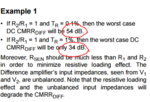M.Rehan
Full Member level 2
Referring to Page # 4 https://ww1.microchip.com/downloads/en/AppNotes/01332B.pdf

What does this means?
Do I have to use op amp with greater value of CMMR db?
Or there may be this much error at output?

What does this means?
Do I have to use op amp with greater value of CMMR db?
Or there may be this much error at output?